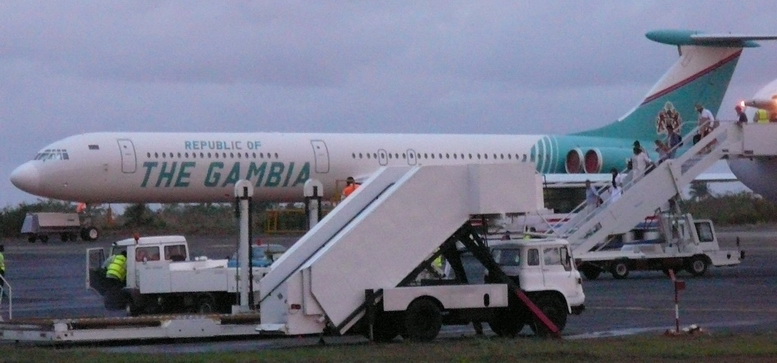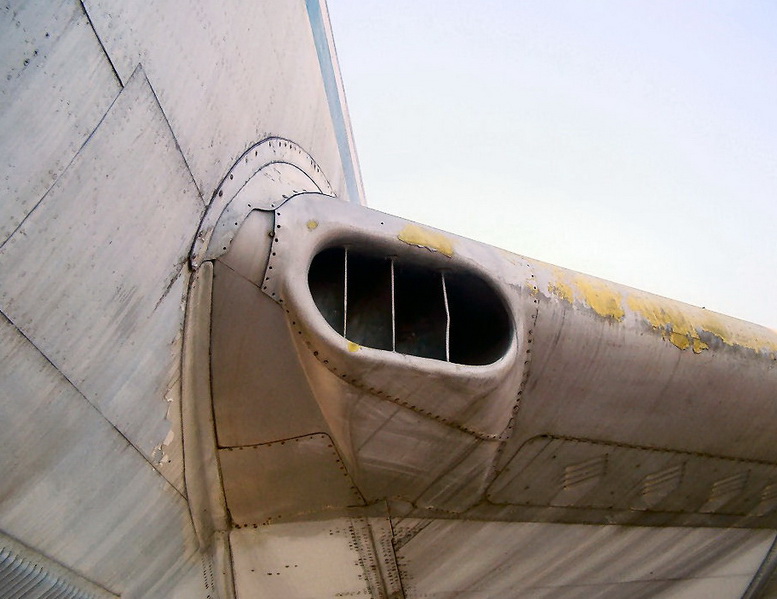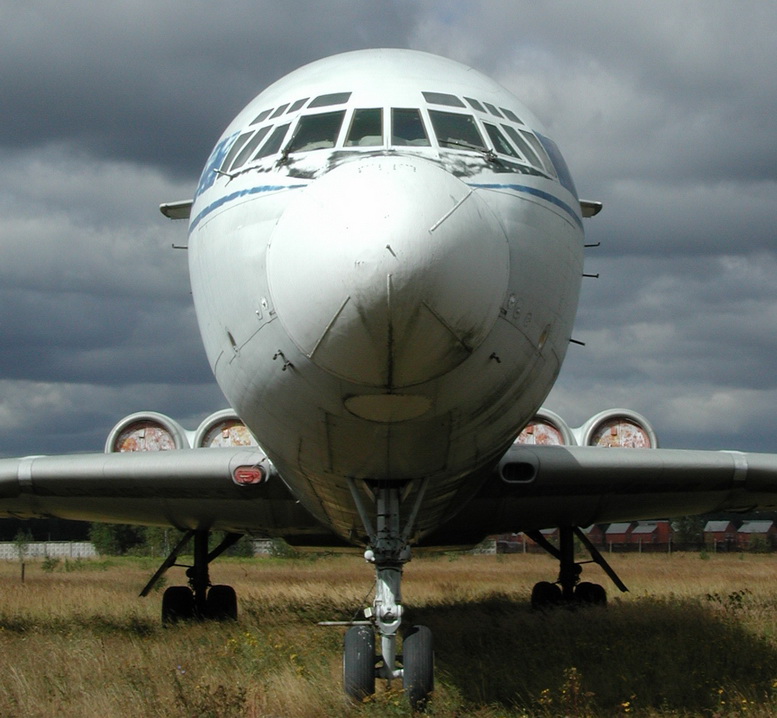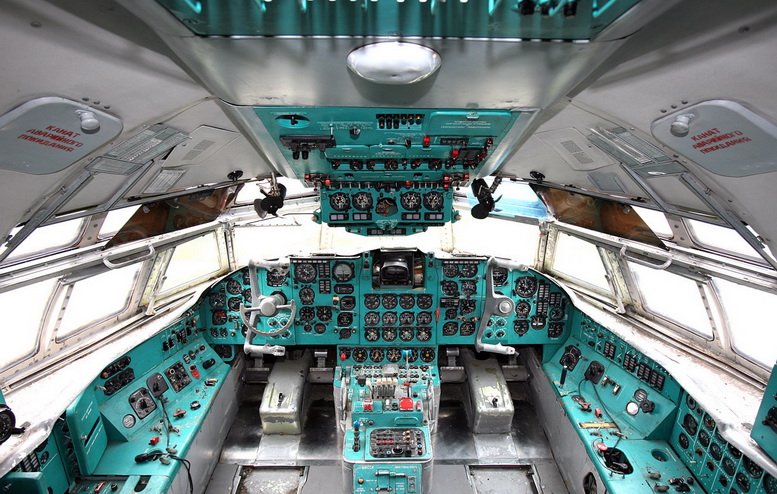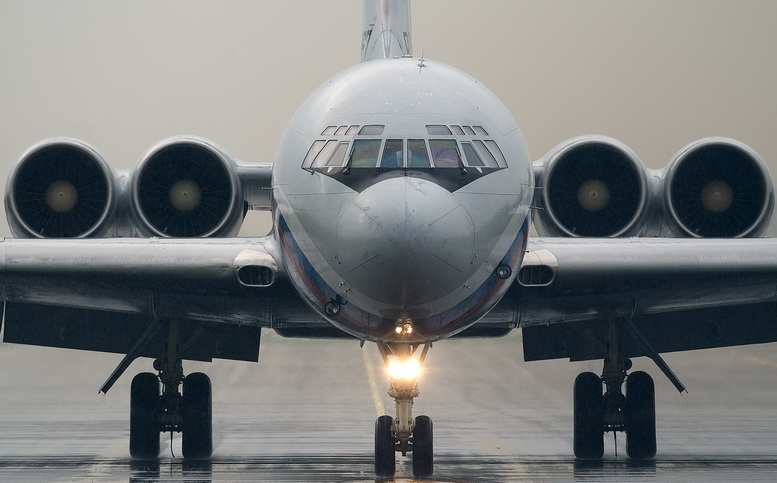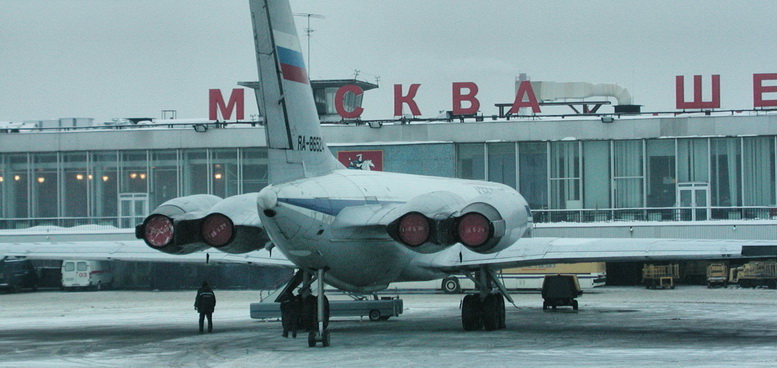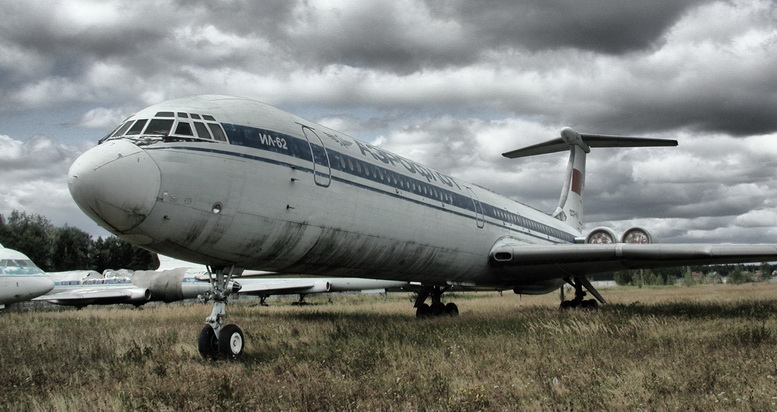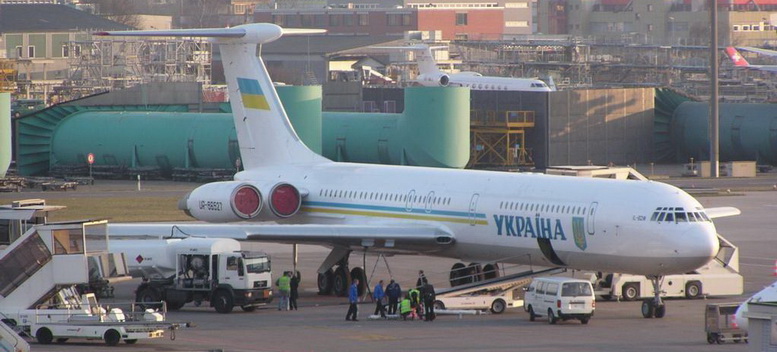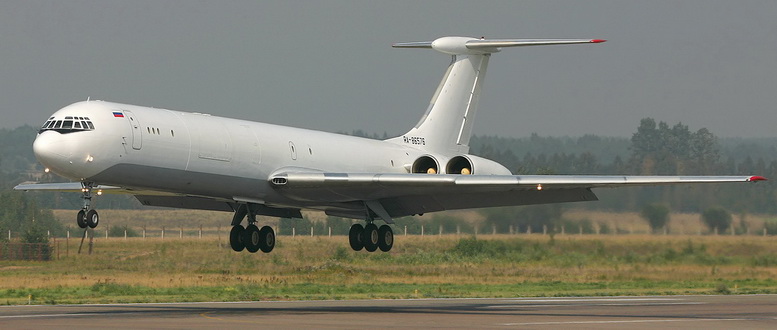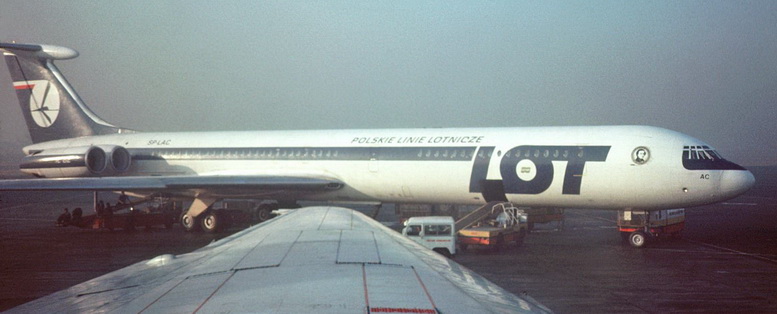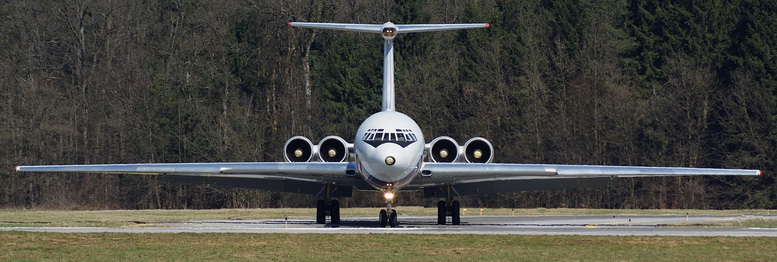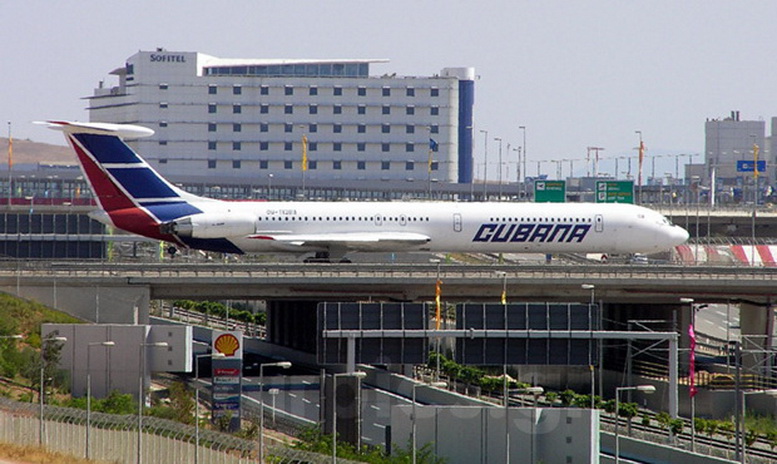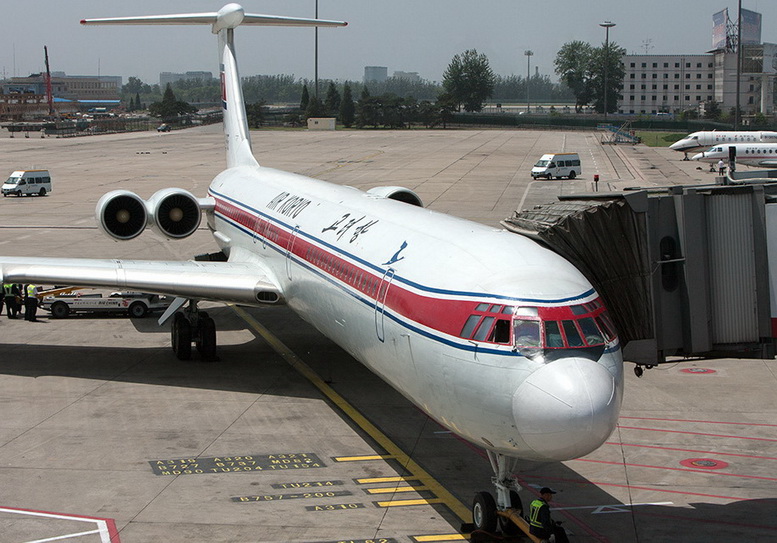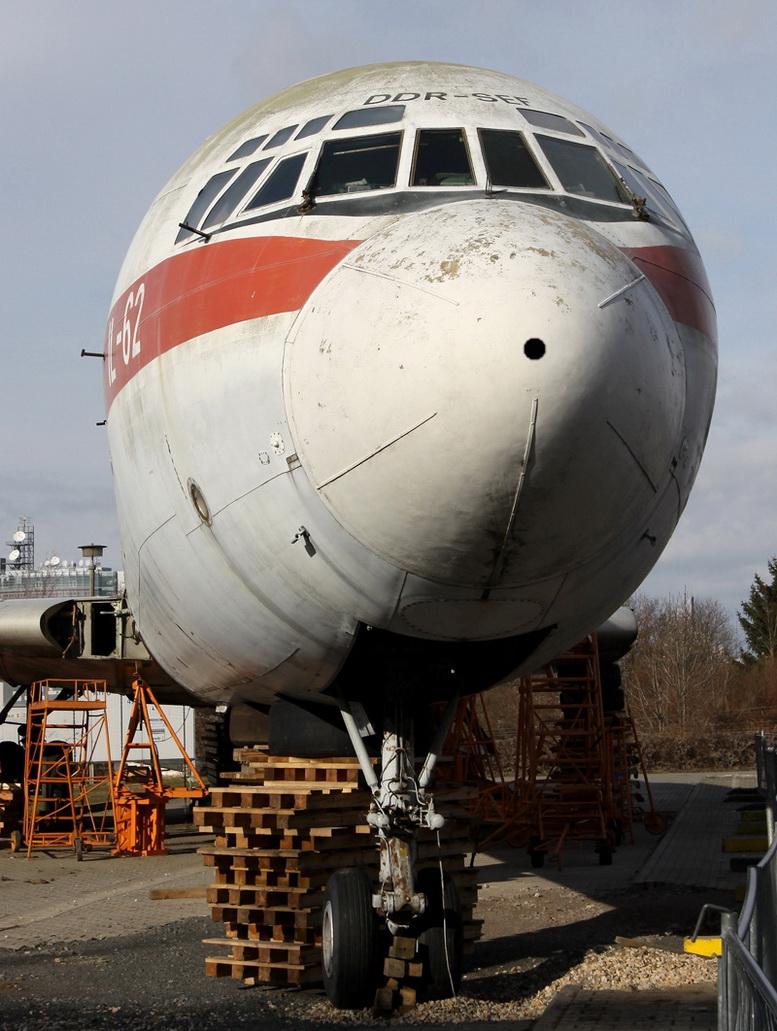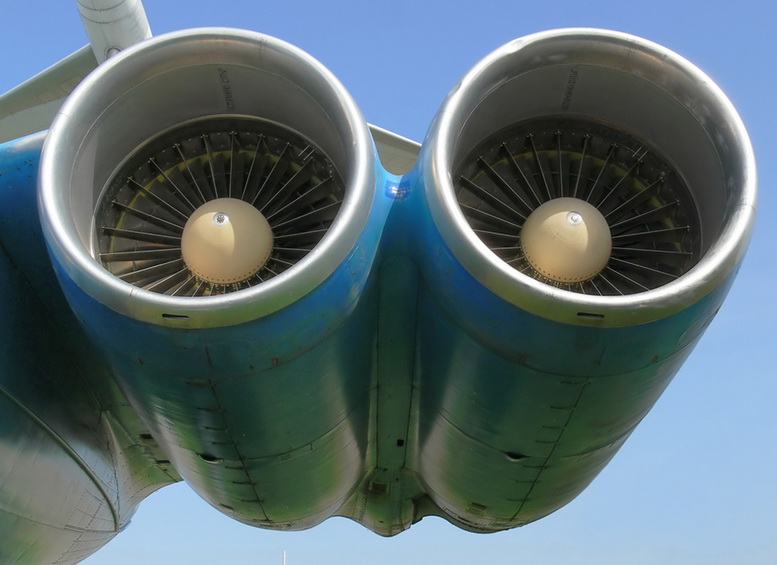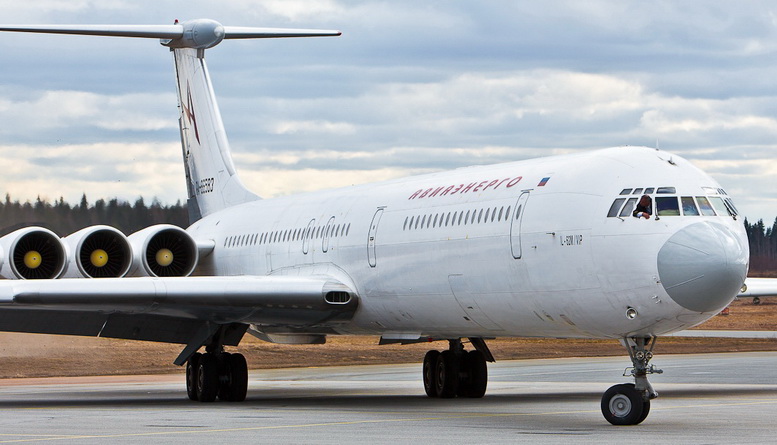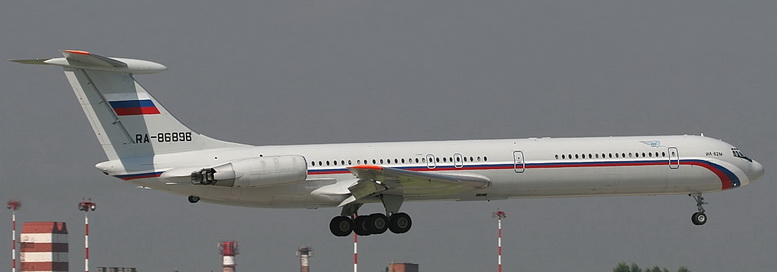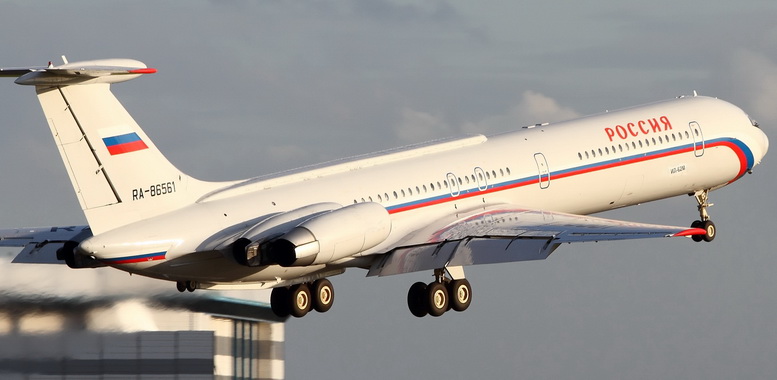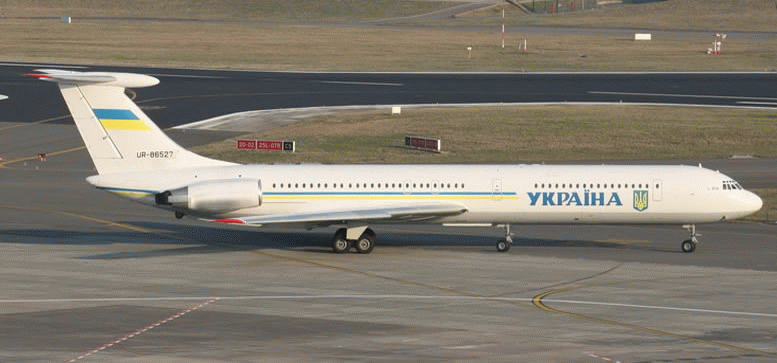ILYUSHIN IL-62 (NATO NAME CLASSIC) SOVIET LONG-RANGE JET AIRLINER AIRCRAFT HISTORY INFORMATION PICTURES AND FACTS
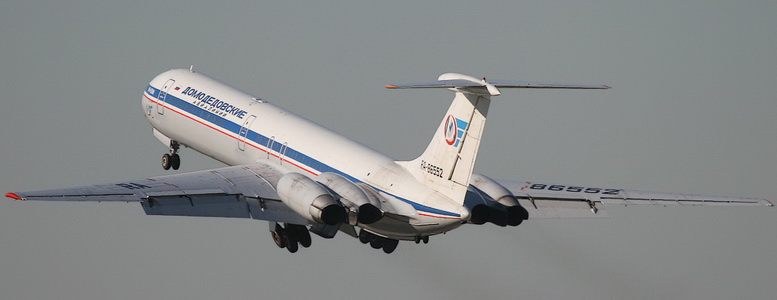 |
The Ilyushin Il-62 (NATO name Classic) is a Soviet long-range jet airliner conceived in 1960 by Ilyushin.As successor to the popular turbo-prop Il-18 and with capacity for almost 200 passengers, the Il-62 was the largest jet airliner when it first flew in 1963. It entered Aeroflot service on 15 September 1967 with an inaugural passenger flight from Moscow to Montreal. One of four pioneering designs (the others being Boeing 707, DC-8, and VC10), the Il-62 was the first such type to be operated by the Soviet Union and a number of other nations, becoming the standard long-range airliner for several decades. It was the first Russian pressurised aircraft with non-circular cross-section fuselage and ergonomic passenger doors, and the first Russian jet with six-abreast seating (the turbo-prop Tu-114 shared this arrangement) and international-standard navigation lights.
Over 30 nations operated the Il-62 with more than 80 being exported and others leased by Russian-sphere and Western airlines. Special VIP (salon) and other conversions were also developed. The Il-62M became the longest-lasting model in its class with some being in civilian service for three decades. Expensive to operate compared to new generation airliners, the number in use was reduced after the 2008 recession. The Il-62's successors include the wide-bodied Il-86 and Il-96, both of which were made in smaller numbers and not widely exported.
The Ilyushin OKB presented a proposal for a four-engined long-range jet airliner in February 1960, receiving the go-ahead from the Soviet Council of Ministers on 18 June 1960, with the Kuznetsov Design Bureau being instructed at the same time to develop the NK-8 turbofan to power the new airliner. The official specification required that the airliner, designated Il-62, must carry 165 economy-class passengers over a distance of 4,500 km (2,800 mi) or 100 first class passengers over 6,700 km (4,200 mi).
The Il-62 replaced the fast turboprop Tu-114 on long range routes. As the Tu-114 was just entering service when the Il-62 was on the drawing board, Ilyushin had time for an unhurried design, test, and development program. This was useful, since the Il-62 did call for significant development.
The Il-62 and the British Vickers VC10 are the only commercial airliners with four engines fitted in twinned/paired nacelles by the sides of, and beneath, a "T" shaped empennage (T-tail), although the Lockheed JetStar business jet shares this configuration. In the case of Ilyushin, the configuration was dictated by TsAGI, the Soviet Union's aerospace agency, since Ilyushin's design bureau lacked the resources to engage in configuration studies. This layout allowed the wing design to be optimised for aerodynamic efficiency, without being cluttered by having to carry engines. In addition, the rear mounted engines reduced engine noise in the cabin and allowed smaller vertical tail surfaces (as the yawing moment in the event of an engine failure was reduced compared to wing mounted engines). These advantages are balanced by a number of drawbacks. The wing structure, without wing mounted engines to relieve the wing bending moment, need to be heavier, as did the rear fuselage structure, which had to carry the engines. In addition, aerodynamic wash (shadow) from the wing blankets the tail when the nose is pitched up (high angle of attack) leading the aircraft into a condition known as deep stall. This called for complex and (in the 1960s) unreliable automatic stall warning systems such as stick shakers and stick pushers to prevent the aircraft getting locked into the deep stall condition, although the Il-62's wing was designed to prevent deep stall.
Early aircraft (prototypes, pre-production and initial production aircraft) display an evolution from thin or thick kinked leading inboard edges to the ultimate thick and straight 1966 shape. The characteristic "dog tooth" also moved until fixed before production began. The engine installation also evolved, with the engines' longitudinal axes canted by 3 degrees from the horizontal; thrust reversers were added to the outer engines, and the entire installation was slimmed down as production began.
The prototype was grossly-underpowered. Its intended NK-8 engines were not ready and small Lyul'ka R-7PB turbojet engines had to be installed temporarily. The prototype with the R-7PB engines first flew on 3 January 1963. It crashed after clipping a perimeter fence during the development program. The production Il-62 was powered by the originally intended rear-mounted Kuznetsov NK-8-4 engines. The first Il-62 powered with NK-8 engines first flew in 1964.
The Il-62M variant (first flight in 1971, introduced in 1973) has more powerful and quieter Soloviev D-30KU engines and a fin fuel tank. Beneath the skin, the Il-62M has simpler and lighter single-slotted flaps and incremental aerodynamic improvements. Most important of these was the addition of spoilerons (spoilers or wing-mounted air brakes which act as ailerons by differential deployment in cruising flight) and the ability to use idle reverse thrust in flight during the final approach so as to shorten the landing run. Nearly all examples in service today are Il-62Ms. In 1978, the Il-62MK was further developed to seat up to 198 passengers and carry some two tonnes (4,400 lb) more payload and/or fuel than the Il-62M.
A version designated Il-62MK was designed as a much modified medium-range machine, though it never reached high production and was dropped from the programme by 1978 (although Germany operated two examples). Other versions were also planned, some "stretched" to seat up to 250 passengers and others suited to small airfields. None of those reached the detail design stage. No civil/military or military developments are known.
The Il-62 has a conventional landing gear with an additional trademark lightweight landing gear strut at the rear of the fuselage which extends when the aircraft reaches its parking position. Aircraft with rear-mounted engines are usually tail-heavy when sitting empty on the ground, and to prevent the aircraft from tipping up on its tail, various devices are used for supporting the tail - from simple "pogo stick" fixed struts on small aircraft, to light-weight extendable struts (Il-62). Aircraft like DC-9, MD-80/90 or Boeing 727 use an airstair door under their tail which serves the dual purpose of a tail support as well as an extra door for passenger loading.
The Il-62 is the largest airliner with manual flight controls, using steel cables and rods, pulleys, aerodynamic and weight balances, and trim tabs. There are also indications that the Il-62 has a forward-mounted tank for water ballast. This may be used when the aircraft flies empty or lightly loaded. If this is a fact, it would rank the Il-62 alongside other airliners that use ballast, notably the French Caravelle and the Soviet Tu-154. Due to the rear mounted powerplants, the wings are aerodynamically clean, and takeoff and landing aids are employed without the disturbing effect of engine nacelles, resulting in free airflow over the dorsal wing surface. Thus the aircraft can fly through air turbulence of 16–18 m/sec without affecting its stability (Thiel, 2001).
Another key Il-62 trademark is the "saw tooth" ("dog-tooth") on the wing leading edge. This prominent feature acts as an aerodynamic fence vortex generator (without which the wings would be almost vortex-free), and fixed leading edge droop/slat/flap. It ensures vice-free behaviour at high angles of attack and assists efficient long-range cruise. The saw tooth removes the need for hydraulic controls, stick shakers, and stick pushers. Interestingly, later models of the VC10 (for British United Airways and Ghana Airways) also adopted this feature, in their case closer to the wing tips.
Early NK-8-4-engined Il-62s suffered from indifferent performance as well as engine fatigue/overheating, sometimes leading to false fire alarms whereby the crew might be tempted to shut down paired engines to prevent contiguous engine and fuselage damage. Flying with only two paired engines on the same side would, however, render the aircraft unbalanced and difficult to control. Subsequent modifications to the Il-62 and the VC10 (which had a similar engine arrangement) largely rectified this problem. There were two fatal Il-62 losses involving engine failure, both occurring with aircraft owned by LOT Polish Airlines, which had also leased a number of Il-62s from Aeroflot and Tarom. The higher fatality accident (183) was a fully laden Il-62M Flight 5055 on 9 May 1987 which experienced a rear fuselage fire that possibly went unnoticed by the crew, hence their decision not to land at one of two nearby airports. Control of the plane was eventually lost on the return flight to Warsaw, most likely due to one of the auxiliary fuel tanks fitted to some LOT Il-62s having ignited. The other was an unmodified (early version) NK-8-4-powered Il-62 Flight 007 which crashed on 14 March 1980 with 87 fatalities after being fitted with an engine that had previously caused vibration problems when used on two other LOT aircraft (the investigation suggested that the turbine disc was damaged before its final installation).
Powerplant failure of the type that afflicted the LOT aircraft was extremely rare because bearing wear is generally identified by vibration tests during maintenance. At the time, however, LOT did not have equipment to test or fault-diagnose engines of the size used in the Il-62. Unfortunately this meant that any potential problem might not be identified between overhauls. There were other known instances of engine failure (e. g. YR-IRD & CU-T1283) but these did not result in loss of control. The LOT accidents involving different engine types (but same engine position) was a fatal crash-rate 30 times higher than the Il-62 average (2.8% vs 0.092%). At least one other LOT Soloviev D-30-equipped aircraft (Tu-154) also suffered a similar engine failure (non-fatal) around this time. After 1987, LOT introduced turbine vibration-detecting equipment and shortened the time between inspections. It also adopted the dual flight control system used on some other Il-62s and deleted the auxiliary engine-pod fuel tanks. These planes were subsequently onsold to Air Ukraine in 1991/1992 which operated them until the airline closed in 2000. In 2010, 30 years after the loss of Flight 007, an investigation of previously unreleased IPN archives at Instytut Pamieci Narodowej revealed that during the industrial unrest of the 1980s LOT had been instructed by the PRL authorities to effect operational cost savings by over-exploitation of service life of its jet engines.
Special Il-62 conversions Several special conversions were made to the basic Il-62, the main ones being the Il-62 and Il-62M salon VIP versions used by heads of state, and the Il-62M airborne command aircraft (just one example) used by the Russian government (Gordon et al., 2004). Although the Il-62 had been introduced during Khrushchev's time, it was during the Brezhnev era that Ilyushin was asked to develop the salon versions which have been used by Russian leaders ever since right up to the Putin years (during which time both Il-62 and Il-96 aircraft were used in combination). The VIP examples were fitted with conference rooms and rest areas, rooms for the retinue, and service personnel and bodyguards, while the secure communication equipment enabled contact with Moscow and other cities from any part of the globe. Examples were also delivered to other countries including Czechoslovakia, Germany, North Korea, Sudan and Ukraine.
The single airborne command Il-62M (RA-86570) was customised for the emergency response agency EMERCOM to provide evacuation transport for Russian citizens from foreign countries and act as airborne command post for these and other emergency situations (Gordon et al., 2004). It operates in conjunction with a fleet of Il-76, Il-76TD waterbombers, An-72 and helicopters which have operated in some 60 countries and saved 50,000 lives since the agency was created in 1994. Apart from basic interior changes, RA-86570 features hush-kitted engines and Honeywell electronics with global communication ability via satellite, and an Inmarsat system. The aircraft was used as a command post during the combat of forest fires in the Far East, when dealing with the Chechen terrorist attack in Kaspiysk when an apartment building was blown up, and to bring Russian Vice-Minister of Foreign Affairs to Sharjah in 1997 and from there collecting the crew of an Il-76 freighter that had escaped from the Taliban militia in Afghanistan.
The Il-62 is a conventional all-metal low-wing monoplane of riveted sectional semi-monocoque construction to fail-safe design principles (a structure designed so that failure of one major member does not cause immediate failure of the whole). Its service life was initially set at 30,000 flight hours and subject to extensions and curtailments according to the quality of service procedures, inspection and manufacturer's bulletins. The aircraft features pressurised cabin and freight holds (with fuselage dimensions of 3.8m width x 4.1m height), duplex all-mechanical flight controls, though with twin electric motors for tailplane incidence control; hydraulic nosewheel steering, landing gear and tail strut actuation, and wheel brakes. The Il-62M has spoilers and lift dumpers which extend automatically upon landing and are hydraulically operated. Control surfaces include a variable-incidence tailplane with dynamically and weight-compensated elevators with trim tabs, triple-section tabbed ailerons (outermost for low speed and innermost for high speed) which are interlinked with a torsion bar, spoilerons (Il-62M), spoilers and lift dumpers, and pneumatically actuated thrust reversers on the two outboard engines (the reversers are flight-rated on the Il-62M).
27V AC electrics are used throughout with a TA-6 auxiliary power unit (a turbine generator which supplies electric power and air conditioning on the ground) in the lower tailcone plus backup lead-zinc batteries.
The aircraft uses conventional hot air de-icing using engine bleed air. Its sea level is equivalent to 2,400 m (8,000 ft) above mean sea level and thereafter reducing to the equivalent of 2,400 m (8,000 ft) to cruise altitude. It was originally built with no automatic oxygen masks; emergency supply comprises hatrack-housed oxygen bottles and masks for manual distribution to passengers by cabin crew. Since 1997, most aircraft have been retrofitted with automatic oxygen supply systems with drop-down masks.
Its avionics include a Polyot-1 automatic flight control system (a "super autopilot," able to be programmed with a set route which it can fly without human intervention but under constant flight crew monitoring; ICAO Cat. 1 approaches standard, Cat. 2 optional), Doppler navigational radar replaced by triplex INSS (Inertial Navigation System Sets) on Il-62M after 1978 and by GPS (Global Positioning System) navigation sets on many aircraft after 1991, triple VHF and HF flightdeck radios, automatic direction finders, Soviet and Western instrument landing system receivers, vertical omindirectional radio range and radio beacon receivers, duplex radio altimeters, automatic radio transponders, a full ICAO-standard navigation lights fit, cabin tannoy and intercom systems. Soviet/Russian and Warsaw Pact sovereign examples are additionally fitted with triplex "Odd Rods" (NATO code name) IFF (identification friend or foe) air defence transponders identifiable by three closely spaced short aerials. Emergency evacuation systems include inflatable life rafts and manually extendable canvas evacuation slides. Most aircraft are now retrospectively fitted with emergency floor lighting strips and some aircraft equipped with automatically inflatable evacuation slides. Fire extinguishers are sited in engine nacelles, flightdeck compartment, cabin crew rest areas and toilets. The Il-62 offers accommodation for up to 198 passengers in a single-class layout, seated six-abreast at 84 cm (33 in) seat pitch in two cabins separated by a vestibule, galley/pantry and cabin crew rest area. There are three toilets, forward, midships, and aft. It has a buffet/bar and a further cabin crew rest area in a vestibule forward, with a further optional cabin crew rest area aft. Typical mixed-class accommodation ranges between 128 and 144, seated four or six abreast, and a common single aisle configuration for long distance Aeroflot examples was first class (2-abreast) 3 rows, business class (3-abreast) 4 rows, economy class (3-abreast) 17 rows (Thiel, 2001). In this configuration, the central aisle in business and economy classes is quite narrow. A first class compartment is optionally sited aft of forward entry door or just forward of midships entry door, with an economy compartment further forward in the latter case. "Skycot" fitments are located in hatracks, while later Il-62Ms (1978 onwards) feature enclosed hatracks. Customer-optionable interior fitments. No in-flight entertainment systems are available except a public-address system that may be coupled to an open-reel or audio cassette player. Individual aircraft were experimentally fitted with television sets for Soviet-standard videotape entertainment during the 1970s. Some aircraft were retrospectively fitted with Western in-flight entertainment (solely audio) systems after 1991. A sideline to the Il-62 story concerns alleged industrial espionage. As the Il-62 was developed at about the same time as the VC10, to which it bears a marked external resemblance, British Cold War commentators implied that the VC10 design may have been copied by dubbing the Il-62 the "VC10-ski." (Thiel, 2001). No evidence of this has ever been presented and, as noted above, later model VC10s used some of the Il-62 wing design features (the Il-62-type landing-gear was also adopted by several leading aircraft manufacturers). There are significant differences between the Il-62 and the VC10, as the Russian type is larger, lifts a greater load, covers a longer range, and is suited only to developed airports vis-a-vis the British type's adaptability to "up-country" bases. Unlike the VC10, the Il-62 uses conservative technology, such as mechanical control surface linkages, and is an entirely civil machine, whereas the VC10 was designed to double as an airlifter as well as a military freighter. The Il-62 found more buyers and was built in larger numbers than the VC10 (292 vs 54), and was still in civilian service (as at 2010) whereas the VC10 has long been retired from that role (in 1966 BOAC described the aircraft as uneconomic and asked for government subsidies to continue its operation. At the end of its civilian career some VC10s were used by the UK airforce in support roles). China and Czechoslovakia were two countries that considered buying the VC10 (for CAAC and Czech Airlines, respectively), before opting for the Il-62 (see VC10: Sales and airline service). After the introduction of the Il-62M, Aeroflot (the largest operator of the plane) gradually upgraded its old Il-62s with the D-30 KU Soloviev powerplant, which, coupled with engine housing and other modifications, greatly reduced the chance of contiguous powerplant damage. By mid 1973, the airline was operating some 60 Il-62s, and by 1989 this had increased to 165 (Il-62 and Il-62M) (Thiel, 2001). The Il-62M had a dispatch rate with Aeroflot of 97% with some examples logging as many as 17 flight hrs/day, and it was described as the most reliable type in the fleet at that time (Gordon et al., 2004). It set several international records in its class, mostly exemplifying a range capability far in excess of the conservative Aeroflot calculations applied in Soviet times. Some of these records were set by an all-woman crew of five captained by Iraida ("Inna") Vertiprahova. With 10 tonnes of freight, the Il-62M had a maximum range of 10,300 km compared to 9,412 km for the VC10 carrying the same weight. With a 23 tonne payload, the Il-62M range was 8000 km, compared to 6,920 km for a Boeing 707 with maximum payload. Because of its capacity, the plane has been used for emergency evacuation flights, one of the most notable being the landing of an Aeroflot-registered Il-62 at Santiago Airport, Chile on the night of Sep 10th 1973 (the day before the military coup by Augusto Pinochet) in order to evacuate 147 Cuban embassy personnel. The Il-62 was said to be well regarded by pilots and passengers alike, especially for its strong directional stability in high turbulence (although landings are sometimes bouncy), smooth cruising ability and very quiet interior in cruise mode due partly to engine placement (Gordon et al., 2004). Although the original IL-62 was rated for a service life of 23 years and was criticised for heavy fuel consumption, upgraded M versions are sometimes rated for 50 years and have greatly improved operational economics. One of the drawbacks of the original Il-62 design was the lack of a cargo bay roller transfer system, which necessitated manual loading of pre-packaged baggage and cargo thus making preparation of the aircraft rather slow (a cargo/baggage conveyance system is standard on the Il-62M). Conversely, there is relatively easy access to all serviceable mechanical components including the engines (Thiel, 2001) whilst the plane's thrust reversal capabilities allows reverse taxiing without the need for tow-vehicles. Powerplant overhaul intervals varied between specifications and maintenance procedures and between the thrust reverse-capable outer engines and the inner ones. Czech Airlines operated an early Il-62 on a proving basis up to 3000 hrs between overhauls, which was well beyond the recommended (and their usual) intervals which were nearer 2000 hrs (Gordon et al., 2004) although Interflug were able to designate up to 5000 hrs with their service facilities. Subsequent upgrades to some Il-62Ms provided for 6000 hr overhaul intervals (with total engine life of 18,000-20,000 hrs). Later examples of the Il-62M remain in regular commercial service (as at 2012), and the type also sees continuing use as a VIP/head of state transport. Although the plane's safety record does not equal that of new generation airliners, there were no fatal accidents involving an Il-62 between 1989 and 2009 during which time the highest number of planes were in service (Thiel, 2001). With successive Il-62M upgrades and improved avionics, including triplex intertial navigation systems and enhanced flight controls to cope with the worst visibility (IMP, 1997), the plane gained a reputation as a very safe airliner whose record compares favorably with similar airliners, most of which are no longer in civilian use. Its total hull loss rate (7.7%) is lower than those of the Boeing 707 (16.4%) and DC-8 (14.9%), and near that of the VC10/Super VC10 (= 7.8% excluding the three examples destroyed by terrorists) although the VC10 was only in civilian service for 16 years versus 45 for the Il-62 (as at 2012), and only 40 of 54 airframes were airliners (the remainder going to the RAF). Several Il-62/M accidents over the first decades of operation mainly involved runway overruns or aborted takeoffs. The braking system employed the reverse thrust of the outer engines only, and if for some reason one or other failed to engage, the aircraft could become difficult to steer for an unprepared pilot. In seven takeoff or landing accidents there were no fatalities, a testament to the high level of structural integrity (and in two cases with landing-related fatalities [CCCP-86470 and UP-16208] these were due to the aircraft colliding with structures near the runway [tower and concrete wall, respectively]). The Il-62/M fuselage features a strengthened hull with 'ski' keel originally designed to allow for an undercarriage-up emergency landing (in practice the undercarriage and landing gear proved extremely reliable). However, the trade-off for the reinforced airframe is the relatively high fuel consumption and some airlines such as Interflug modified their planes to reduce fuel consumption (Thiel, 2001). |
© AviationExplorer.com - The Website For Aviation Enthusiasts |





